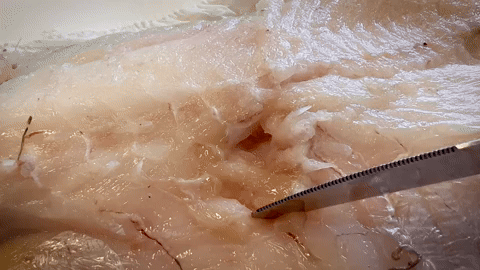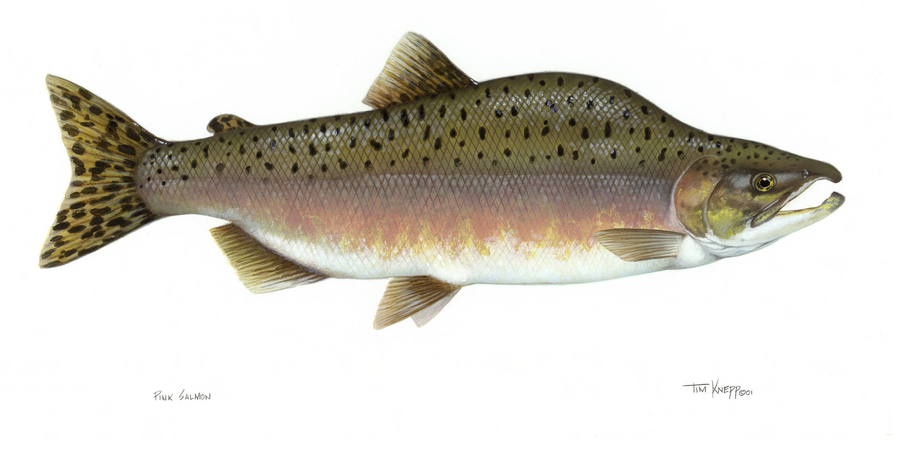Searched for Anisakids in tusk, stumbled upon fish-liquefying parasite

The examined tusks come from the IMR's longline survey for spiny dogfish. (It's the freezing and thawing that have caused the worn appearance here, not the Kudoa parasite.)
Photo: Paolo Cipriani / Institute of Marine Research
A lot of things pass through the sample reception at the Institute of Marine Research. Here, research technician Aina Bruvik is busy sampling the tusks.
Photo: Paolo Cipriani / Institute of Marine Research
Researchers are monitoring the extent of anisakis in Norwegian wild fish.
Photo: Paolo Cipriani / Institute of Marine Research
Lucilla Giulietti is trying to solve the mystery of the Kudoa parasite.
Photo: Paolo Cipriani / Institute of Marine Research
In the microscope, the researchers could see that the mushy tusk fillet was infected with Kudoa – later confirmed by a DNA test.
Photo: Paolo Cipriani / Institute of Marine ResearchPublished: 28.11.2023
The mysterious parasite Kudoa thyrsites causes fish fillets to become so soft they could be consumed with a straw 24 hours after the fish's death.
It is not harmful to humans, but it can ruin a meal and perhaps the dinner guest's relationship with seafood. Documented findings of Kudoa in Norway have been limited to mackerel. Until now.
Searched for one parasite, but found another
“I was actually looking for anisakids, which is my main research focus, but I noticed that my tweezers sank straight into the tusk fillet without resistance. Closer inspection under the microscope revealed the presence of Kudoa spores that had begun to digest the fish,” says IMR researcher Paolo Cipriani.
It was thus completely by chance that the parasitologist found the Kudoa parasite in a tusk from Trøndelag.

A DNA test confirmed the finding as Kudoa thyrsites, which has never been documented before in Norwegian whitefish.
Not uncommon in mackerel
“In our annual screening of commercially caught mackerel, we find Kudoa in 1-3 out of a hundred fish,” says research colleague and Kudoa expert Lucilla Giulietti.
Researchers believed the parasite was something mackerel carried from the southern areas of the Atlantic Ocean, and that it did not actually reside in Norwegian waters.
But Giulietti has also recently found Kudoa in juvenile mackerel, "born and raised" in Norway.
“The more we look for Kudoa, the more we find it,” she says.
May indicate that the parasite is also "Norwegian"
“The findings in juvenile mackerel and the new jelly Brosme from Trøndelag may indicate that there are actually local Kudoa infections, and that the parasite is already established in Norway," Giulietti continues.
Researchers do not know the life cycle of the parasite and do not know how it is transmitted between individuals.
"The key to understand the transmission and potential spread of Kudoa is to understand how the fish get infected and where the parasite goes from there” she says.
It is an important target for further research on the mysterious parasite, especially now that climate and ecosystems are changing rapidly.
Caused trouble in Canadian salmon dinners
“Outbreaks of the parasite have previously caused major problems for salmon farming on the Pacific side of Canada. Liquid fish flesh is something the Norwegian salmon industry probably does not want. It can be devastating for both food and reputation,” she says.
Since the enzymes from the parasite need one to two days to liquefy the flesh, the fish may develop soft when they have already reached the market.
Relatively stable amounts of Kudoa in mackerel
IMR is not aware of cases in Norwegian farmed salmon so far, but Kudoa has not been monitored systematically either in this fish.
Instead, the 19 years-surveillance program that IMR has conducted on mackerel shows that the occurrence in this fish has been relatively stable in samples from Norwegian commercial catches throughout the recent years.

It is the findings in these new locations and hosts that make researchers eager to learn more.
"New" fish can also host the jelly parasite
“Kudoa has also been reported in wild-caught pink salmon in the Pacific Ocean. It is also an interesting species to follow up as a potential host,” says Giulietti.
Pink salmon has become the dominant wild salmon species in Northern Norway every other year.
The possibility of spreading unknown disease is a possible risk associated with pink salmon, which is native to the Pacific.
Report jelly fillet
Have YOU experienced a fish fillet turning to mush?
Report to our researchers through the citizen science portal Dugnad for havet.

